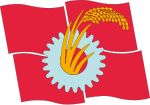Shimbun Akahata
show This article may be expanded with text translated from the corresponding article in Japanese. (December 2020) Click [show] for important translation instructions. |
This article needs additional citations for verification. (August 2017) |
 | |
| Type | Daily newspaper |
|---|---|
| Owner(s) | Japanese Communist Party |
| Founded | 1928 |
| Language | Japanese |
| Headquarters | Tokyo |
| Country | Japan |
| Circulation | 1,200,000[1] |
| Website | Akahata (in Japanese) Japan Press Weekly (in English) |
| |
Shimbun Akahata (しんぶん赤旗, Shinbun Akahata, lit. Newspaper Red Flag) is the daily organ of the Japanese Communist Party in the form of a national newspaper. It was founded in 1928 and currently has both daily and weekly editions.[1]
Akahata has journalists based in the capitals of ten countries around the globe. They are Beijing, Berlin, Cairo, Hanoi, London, Mexico City, Moscow, New Delhi, Paris, and Washington, D.C..
Some of their journalism deals with activist politics, but they also do original reporting on a wide variety of political issues which are often untouched in Japan. Most Japanese newspapers publish the names of alleged criminals, but Akahata often declines to publish their names, unless they are related to organized crime or right-wing activities. They also go out of their way to avoid using polite terms for the Emperor of Japan; for example, the paper refers to the Emperor's Cup exclusively as "a Japanese soccer tournament". They refer to the Buraku Liberation League as the "Liberation" League, using scare quotes to convey their opposition to the group.
Japan Press Weekly is the newspaper's English edition.
Circulation over time[]
In 1959, Akahata had a daily circulation of around 40,000.[2] By the end of 1960, as a result of recruitment drives conducted in conjuntion with the 1960 Anpo Protests, circulation soared to around 100,000.[2] By 1970, the newspaper had over 400,000 subscribers to its daily edition, and more than 1 million subscribers to its Sunday edition.[2] In the early 1990s, daily subscribers were over 3 million. However, by 2007, daily circulation had fallen to around 1.6 million, and fell further to around 1.2 million by 2016.
See also[]
- List of newspapers in Japan
- Japanese media
References[]
- ^ Jump up to: a b A Profile of the Japanese Communist Party. Japanese Communist Party (official website). Published July 2016. Retrieved 8 August 2017.
- ^ Jump up to: a b c Kapur, Nick (2018). Japan at the Crossroads: Conflict and Compromise after Anpo. Cambridge, Massachusetts: Harvard University Press. p. 272.
Further reading[]
- George M. Beckmann, Genji Okubo (1969). The Japanese Communist Party 1922-1945. Stanford University Press.
- Tim, Rees, and Thorpe, Andrew. International Communism and the Communist International, 1919-43 Manchester University Press, 1998.
- Robert A. Scalapino (1967). The Japanese Communist movement, 1920-1966. University of California Press.
External links[]
- Shimbun Akahata (in Japanese)
- Japan Press Weekly
- Japanese Communist Party
- 1928 establishments in Japan
- Japanese-language newspapers
- Daily newspapers published in Japan
- Publications established in 1928
- Communist newspapers

